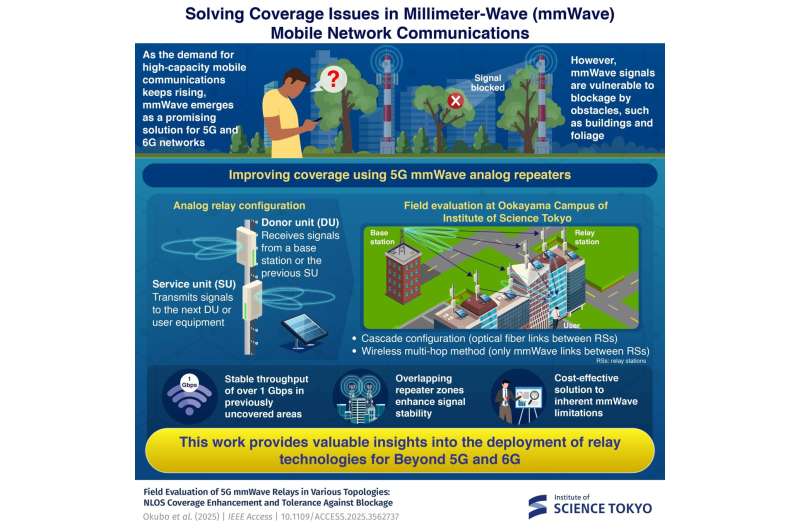Analog repeaters could be the key to practical mmWave deployment
Analog repeaters dramatically enhance millimeter-wave (mmWave) coverage in mobile networks by overcoming signal blockage, report researchers from Science Tokyo. As demonstrated in a field experiment at Ookayama Campus, low-cost repeaters connected either wirelessly or via optical fiber offer a promising solution for 5G and 6G networks. Both configurations achieved over 1 Gbps throughput and enhanced mmWave signal stability, showing strong potential for practical deployment in urban and high-traffic areas.
The global demand for high-speed, high-capacity mobile communications keeps rising every year, pushing the telecommunications industry toward increasingly advanced solutions. Among these, 5G’s millimeter-wave (mmWave) frequencies promise low latency and unprecedented speeds exceeding 1 Gbps, making them ideal for emerging applications, like augmented reality and autonomous vehicles.
However, mmWave frequencies face critical deployment challenges that have hindered their practical implementation. As high-frequency radio signals, they are particularly susceptible to blockage by environmental obstacles, such as buildings, trees, and even human bodies. This limitation makes it both technically challenging and prohibitively expensive to provide comprehensive mmWave coverage while remaining cost-effective.
Against this backdrop, a research team led by Professor Kei Sakaguchi from the Department of Electrical and Electronic Engineering at the Institute of Science Tokyo (Science Tokyo), Japan, has developed and tested a practical solution using analog relay stations to extend mmWave coverage.
Their paper, published in IEEE Access, demonstrates how strategically placed low-cost repeaters can effectively address the key barriers to widespread mmWave deployment.
The team installed multiple sets of analog repeaters within a 5G/6G demonstration field on Science Tokyo’s Ookayama Campus, focusing their experiments on non-line-of-sight (NLOS) environments where direct signals from base stations typically cannot reach. Each repeater set comprises a donor unit that receives signals, and a service unit that amplifies and transmits them to users or forwards them to other repeaters. The researchers evaluated two primary connection schemes: a cascade configuration using optical fiber links to connect repeaters and a fully wireless multi-hop configuration relying solely on mmWave links.
Testing revealed that these analog repeaters enabled stable communication with throughput exceeding 1 Gbps in previously unreachable zones, effectively expanding coverage to areas that were dead spots. The cascade method achieved a slightly higher average throughput, whereas the wireless multi-hop approach showed a more consistent performance with fewer signal drops. Still, both configurations successfully achieved wider-area coverage that would have been impractical to provide with base stations alone.
“Our results demonstrate that proper placement of analog repeaters can overcome mmWave’s inherent blocking loss and support both stable and high-capacity communications,” highlights Sakaguchi.
Another key finding was that overlapping the coverage areas of multiple repeaters created artificial multipath environments, further enhancing signal stability through what the researchers termed “distributed relay diversity.”
“Even when signals were blocked by a human body simulating an obstruction, receiving from multiple repeaters helped maintain signal strength and throughput,” Sakaguchi explains.
In this way, the proposed approach proves particularly suitable for densely populated areas with frequent pedestrian and vehicle movement, where maintaining connectivity is paramount.
Overall, this innovative solution paints a bright future for mmWave in next-generation mobile communications, as Sakaguchi concludes: “Taken together, our findings mark the beginning of efforts toward the realization of breakthrough technologies for Beyond 5G and 6G networks.”
More information:
Naoya Okubo et al, Field Evaluation of 5G mmWave Relays in Various Topologies: NLOS Coverage Enhancement and Tolerance Against Blockage, IEEE Access (2025). DOI: 10.1109/ACCESS.2025.3562737
Institute of Science Tokyo
Citation:
Analog repeaters could be the key to practical mmWave deployment (2025, July 17)
retrieved 18 July 2025
from https://techxplore.com/news/2025-07-analog-key-mmwave-deployment.html
This document is subject to copyright. Apart from any fair dealing for the purpose of private study or research, no
part may be reproduced without the written permission. The content is provided for information purposes only.

Comments are closed